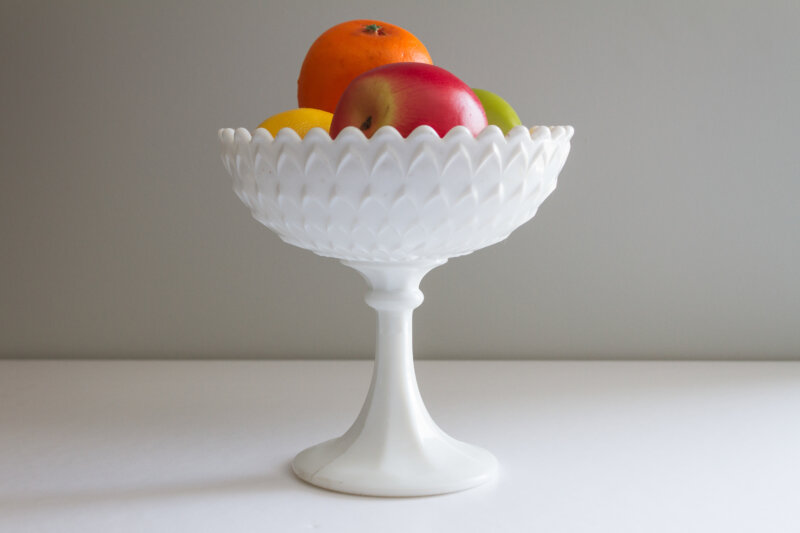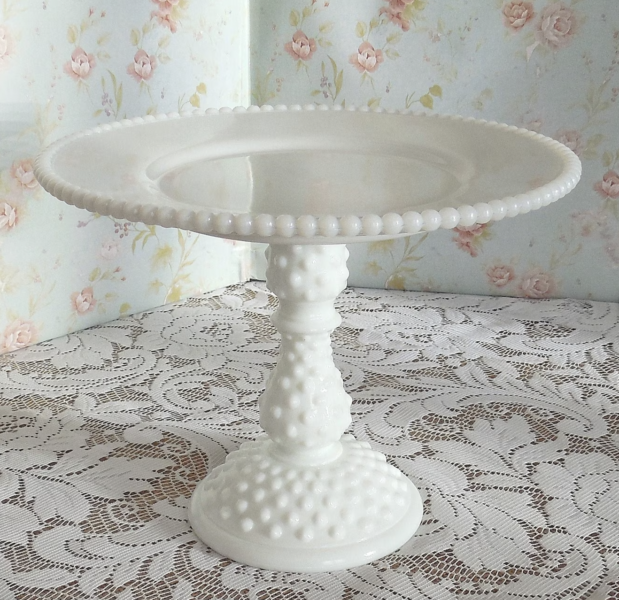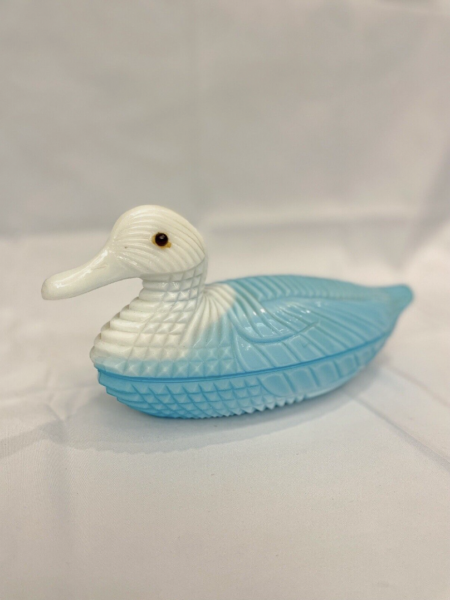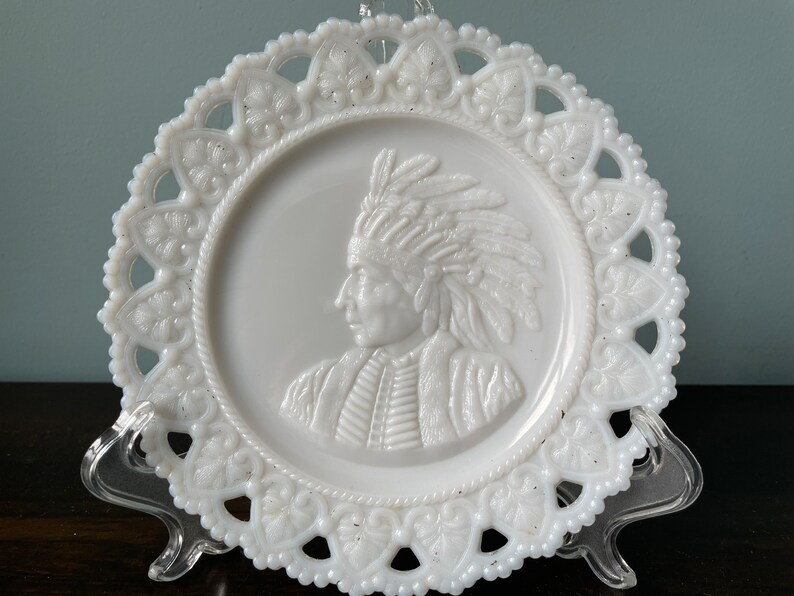Say you’re poking around your grandmother’s attic, and you find a milky-white glass candy dish with a duck lid. Or maybe you’re at a garage sale, and you run across an opaque white glass pitcher for $2. Are these items made of milk glass? And if so, will antique collectors pay a pretty penny to take them off your hands?
The answers here are “maybe” and “it depends.” You’ll have to do a little research to find out for sure. Read on for a breakdown of what milk glass is, why it might be valuable, and how to tell if the kind you’re holding in your hand is worth any money.
What Is Milk Glass?
Milk glass is an opaque white glass used by manufacturers to make all kinds of household items including dresser trinkets, lamps, serving pieces and vases. It’s made by mixing an additive (like lead, tin oxide or arsenic) into a standard glass recipe, which tints the coloring to a “milky,” opaque white (and sometimes other colors like creamy light green, pink or blue).

Variations of milk glass have been around for centuries, but these days, it tends to refer to the white glass that was popular in the U.S. and England from 1835 through the 1980s. Milk glass was an inexpensive substitute for porcelain and was used to create high-quality-looking dessert plates, cake stands, tea cups, punch bowls and covered dishes. While manufacturers tended to produce entire dish sets out of porcelain or ceramic, they used milk glass for one-off items like salt shakers or candy dishes.
What’s So Special About Milk Glass?
Certain milk glass pieces are coveted worldwide by vintage glassware collectors, decorators and designers. But the value of milk glass varies widely depending on its condition, age and availability.
On one hand, milk glass was produced consistently for decades, so there’s a lot of it out there (and a handful of companies are still producing it today). So, according to Love to Know, the typical milk glass vase you’d find at a garage sale or antique shop isn’t worth more than $10 to $30 per piece. On the other hand, the older the milk glass is, the more money it will fetch. Nowadays, collectors tend to focus on milk glass that came out of one of two eras.
MORE: 9 vintage kitchen items that could be worth hundreds (or thousands) of dollars
“Milk glass popularity is divided basically into two camps,” Christine Browning, president of the National Milk Glass Collectors Society, told Martha Stewart. “Those pieces that were made in the Victorian era, circa 1870 to 1910, and the resurgence in the 1950s.”
A milk glass and brass lamp from that first era (early 1900s) could sell for several hundred dollars.
And pieces from the 1950s can go for over $100. For example, this pedestal cake stand from that era is a steal, selling on Etsy for $74:

How To Identify Valuable Vintage Milk Glass
If you have an item that you suspect might be made of antique milk glass, hold it up to the light. Then look for an iridescent ring of blues, reds and greens. If it’s a genuine antique (1960s and prior), it was made with iridized salts, which produce this “ring of fire” effect.
You can also get an idea of the value of your milk glass item by comparing it to photos on the National Milk Glass Collectors Society website.
Then, consult the sites of collectors and appraisers to discover what they are seeking.
“Pedestal planters or jardinaires, pitchers and glass sets featuring fruit or flowers, tapered bud vases, candlesticks, and chalice goblets are all on the ‘must have’ list,” according to the website of Lori Verderame, Ph.D., the antique appraiser on the History channel’s “Pawn Stars Do America,” Discovery channel’s “Auction Kings,” and Netflix’s “King of Collectibles.”
MORE:If You Have One of These Pyrex Bowls, It Could Be Worth Big Bucks
The vast majority of milk glass is white, so if you spot a pink or blue one, you might want to snap it up. “The colored ones are more rare and go for more money,” auctioneer and appraiser Bene Raia told Martha Stewart. “You never see those at thrift stores.”
Love to Know recommends that you look for the logo of certain reputable manufacturers, such as Atterbury & Company — which was known for its figural milk glass piece, the “Atterbury duck,” a lidded animal dish produced in the early 1900s. This Antique Atterbury Blue Milk Glass Duck with White Head Oval Dish with Lid is priced at $120 on eBay:

Other manufacturers to look out for are Bryce Brothers, New England Glass Company and Gillinder & Sons. That last manufacturer did not put a logo on its products but had distinctive designs, including busts of presidents and figural sculptures. For example, this Gillinder and Sons Milk Glass Plate with a Native American design is selling for $79.95 on Etsy.

Ultimately, learning the ins and outs of vintage milk glass takes time and practice. But because of the wide range of prices, collecting milk glass can be a very rewarding experience. You never know when you might stumble upon a truly valuable item.
MORE: How much is your old ceramic Christmas tree worth?
“Education about what you are collecting is very important,” Browning told Martha Stewart. “Reference books are a must, as well as handling glass and getting a feel for older glass versus newer.”
While you’re searching for your next milk glass find, keep an eye out for the seven most valuable milk glass pieces, according to VIP Art Fair:
- Octagonal Punch Bowl
- Duck on Reeds Candy Dish
- Multiple Milk Glass Bowl
- Vintage Hazel Atlas Tom And Jerry
- Milk Glass Paneled Grape Epergne Bow
- White Milk Glass Punch
- Vintage Console Bowl
Happy glass hunting!
This story originally appeared on Don't Waste Your Money.


